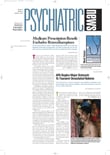Illicit drug use among teenagers dropped slightly over the past year, according to results from the 2004 Monitoring the Future Survey, but the use of inhalants and the narcotic Oxycontin rose.
The data mark the eighth straight year of decline in overall drug use for the nation's eighth graders, and a three-year decline in overall drug use for 10th and 12th graders.
Researchers from the University of Michigan's Institute for Social Research in Ann Arbor began collecting data on drug, alcohol, and cigarette use among secondary school students in 1975.
Last year they interviewed 17,413 eighth graders, 16,839 10th graders, and 15,222 12th graders for a total of 49,474 students in 406 public and private secondary schools in the United States.
The proportion of students who reported any drug use during the past year was 15 percent, 31 percent, and 39 percent among students in grades eight, 10, and 12, respectively.
The proportion who reported ever using an illicit drug in their lifetime was 22 percent for eighth graders, 40 percent for 10th graders, and 51 percent for 12th graders.
Still, alcohol remains the “drug of choice” for older teens—70.6 percent of 12th graders reported using alcohol during the preceding year, and 14.5 percent of eighth graders, 35 percent of 10th graders, and 52 percent of 12th graders reported being drunk during the preceding year.
Students in all three grades showed small, not statistically significant declines in the use of marijuana (including hashish). In 2004, 11.8 percent of eighth graders, 27.5 percent of 10th graders, and 34.3 percent of 12th graders used marijuana during the prior year.
Eighth graders have experienced the biggest drops in marijuana use since 1996, the survey year in which marijuana usage peaked—in 1996, 18.3 percent of eighth graders reported using marijuana during the preceding year.
Findings from the 2004 Monitoring the Future Survey show decreases in the use of other drugs. Among them:
•
Ecstasy use in all three grades peaked in 2001 and has continued to decline since then. Between 2001 and 2004, the annual prevalence of ecstasy use dropped by more than half among 10th and 12th graders. For instance, 9.2 percent of 12th graders reported using ecstasy during the preceding year in 2001, while just 4 percent did so in 2004. Annual use in 10th graders dropped from 6.2 percent in 2001 to 2.4 percent last year.
•
Amphetamine use fell slightly to 4.9 percent among eighth graders and to 8.5 percent among 10th graders over the prior year, but remained steady among 12th graders at 10 percent.
•
The proportion of 10th graders who reported using the painkiller Vicodin during the prior year dropped from 7.2 percent in 2003 to 6.2 percent in 2004. There was also a decrease for 12th graders (from 10.5 percent in 2003 to 9.3 percent in 2004).
•
Since it was first measured in 1979, annual use of PCP by 12th graders has fallen drastically, from 7 percent to 0.7 percent in 2004.
Not all of the news from the survey was positive, however. The use of some illicit drugs remained steady between 2003 and 2004, according to the results. For example:
•
Although there were major declines in annual LSD use between 1999 and 2003 for 10th graders (from 6 percent to 1.7 percent) and 12th graders (from 8.1 percent to 1.9 percent)—use for both grades remained steady over the last year.
•
Rates of cocaine and heroin use have remained fairly steady over the past several years. About 5 percent of 12th graders said they used cocaine in the preceding year, and 1 percent reported heroin use.
The survey also found that the use of some drugs by teenagers increased last year.
Researchers began monitoring Oxycontin use in 2002 and last year reported some increase in annual use among all three grades. While use among eighth and 10th graders last year remained stable, the proportion of 12th graders who reported using Oxycontin during the previous two years rose from 4 percent in 2002 to 5 percent last year.
“Considering the addictive potential of this drug, which is a powerful synthetic narcotic used to control pain, we think that these are disturbingly high rates of involvement by American young people,” said Lloyd Johnston, Ph.D., the study's principal investigator, in a press release from the University of Michigan.
In addition, the use of inhalants rose among all three grades from 2003 to 2004. Inhalants encompass a range of substances such as paint thinner, butane, and nail-polish remover, for instance.
In 2004 past-year inhalant use was highest for eighth graders (9.6 percent). About 6 percent of 10th graders and 4 percent of 12th graders used inhalants over the preceding year.
The National Institute on Drug Abuse sponsors the Monitoring the Future Study each year.
The results of the 2004 Monitoring the Future Study are posted online at<www.monitoringthefuture.org>.▪

